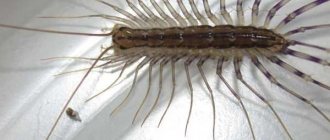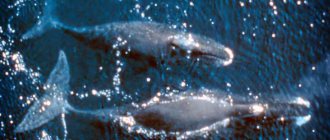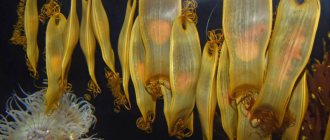Dolphins are generally considered to be inhabitants of the sea and ocean, so it would be strange for many to imagine them making their way through a narrow channel in the Amazon rainforest or through muddy channels in rural Bangladesh. However, it is precisely to these conditions that the heroes of this article, river dolphins, have adapted.
Dolphins are representatives of the order Cetaceans, the suborder Toothed whales, and the Dolphin family. There is also a superfamily of River dolphins. Research has shown that they evolved from oceanic species that had to move to riverine habitats due to competition with other species.
Description of the dolphin and features of its structure
animalreader.ru
Currently, there are four species of river dolphins:
- Amazon river dolphin. It is a rather large animal with small eyes and a thin mouth, curved towards the tips. Individuals have a low dorsal fin, their flippers are triangular, wide and have blunt edges. The color of specimens ranges from white to gray and even pink.
- Baiji. This freshwater dolphin is found only in the Yangtze River. Individuals have a pale blue or light gray tint, their abdomen is predominantly white. The baiji has a low triangular fin, a raised mouth and small eyes set high on the head.
- Valley of the Ganges River. Individuals are distinguished by a powerful structure, have developed muscles and a fairly flexible body with expressive dorsal fins. Young specimens are brown in color and become gray when mature. Females of this species are larger than males, their length exceeds 2.5 m. They are distinguished by a late onset of sexual maturity, which is why the population decreases annually.
- La Plata dolphin. It has an interesting structure; it has a very large mouth, which is considered the largest among dolphins. Representatives of this species reach a length of 1.5 meters and weigh 50-60 kg.
River dolphins are also the blue whale's closest relatives and are also considered mammals.
River dolphins. What is their fate?
Dolphins are aquatic animals, mammals from the order Cetaceans. Zoologists divide them into 43 species: 38 belong to the family of marine dolphins, the rest to the subfamily of river, or freshwater, dolphins. River dolphins live in inland waters, rivers and lakes.
Based on archaeological finds, scientists believe that dolphins were previously terrestrial animals, but then, due to natural conditions, they were forced to move into the water element, to which they successfully adapted.
A tragic fate befell the Chinese river dolphin, which from time immemorial lived in China's deepest river, the Yangtze, which is 6,300 km long. These animals were also found in the Qiantan River and two lakes - Dongting and Poyang. Residents of Ancient China called white dolphins goddesses of the Yangtze, honored and protected them.
In 1918, zoologists compiled a description of the animal - the Chinese river dolphin, discovered in Lake Dongting. The locals called it baiji, which means "flag" - the dorsal fin of this dolphin looks like a flag. The species' scientific name is also based on this similarity and is Latin for "flag bearer".
The rapid technological progress of the twentieth century did not ignore the habitat of these beautiful animals. The Yangtze was filled with industrial waste, hydraulic structures disrupted the natural water balance of the river, and river transport disrupted the silence of the waters.
And already in 1979, the Chinese dolphin was included in the list of endangered animals, and by 1990 its population had decreased to 200 individuals. The death of the Yangtze goddesses was inevitable, and in 2006 an expedition, armed with the latest technology, set out to comb the river in the hope of finding white dolphins, but people did not find a single sound made by these animals.
In 2007, China's Endangered Animals Commission declared the white dolphin species extinct.
What were they like? The body length of the Chinese river dolphin ranged from 1.5 to 2.5 meters, weight - 80-160 kg. The dorsal fin, similar to a flag, was located closer to the tail. The respiratory organ was located on the crown. Baiji had poor eyesight and navigated using echolocation.
Interestingly, the researchers believe that each individual had its own unique sound, which can be regarded as the proper name of a particular animal. The color of the Chinese dolphin is light blue or grayish-blue, and its belly is white. The white dolphin ate fish and shellfish. With the help of a long so-called beak, he dug out prey from river silt.
Scientists have little information about the life of river dolphins. They suggest that the female gave birth to only one cub every two years.
These are the sad lessons life teaches people. But how rarely does a person listen to them - the thirst for profit overshadows the mind, and more and more new animals and plants disappear from the face of the Earth.
The fate of the pink dolphin, or the Amazonian river dolphin - inia, is not so sad. Locals call them boto. Inia's appearance is very attractive: thanks to genetic albinism, they have a pink color throughout their body. But their disposition, despite their playfulness and curiosity, is quite aggressive, which is why they are practically not kept in dolphinariums.
Photo: Depositphotos
In the largest river in the world, the Amazon, there is plenty of room for pink dolphins. But, nevertheless, there is a struggle to preserve this species. The fact is that the genitals of the Amazonian dolphin are considered an aphrodisiac, and there are enough hunters for this amazing animal for profit.
Adult inias grow up to 2.5 meters and weigh 85-160 kg. Babies are born weighing only 7 kg and a body length of about 80 cm, so the first weeks of life require the care of their mother.
These animals feed on fish and crabs. Like Chinese dolphins, inia has a long snout, similar to a beak, with the help of which the animal extracts crustaceans from the mud.
Pink dolphins can make echolocation clicking sounds and sounds similar to barks, squeals, screams, and whimpers, but they cannot whistle.
Photo: Depositphotos
The Indians have created many legends about this beautiful animal. One of them says that on moonlit nights, female pink dolphins come ashore and turn into charming beauties with long silky hair. Seeing a lonely male traveler, they lure him into the deep waters of the Amazon with their voluptuous singing.
There is also a legend about male dolphins who turn into beautiful young men and take part in Indian holidays. During the dance, they choose the most attractive girls and seduce them.
Children allegedly born from dolphins were loved in Indian families as if they were their own, and the woman was not punished for such a sin.
I would like to believe that people are smart enough to save this wonderful animal, which has every right to live in its natural habitat.
Tags: dolphin, animal description, river dolphins, aquatic animals
Where do the river dolphins live?
Each of the 4 species of river dolphins has its own habitat:
- The Amazon dolphin is found in the basins of the river of the same name and the Orinoco, perhaps in tributaries and lakes, its migration is disrupted due to the construction of dams;
- the Chinese dolphin Baiji lives in the deltas of the Yangtze River, individuals form pairs or groups of up to 10-16 individuals;
- Ganges River dolphins are found in the Upper Ganges, in the Chambal, Gandak, Ganga, Son, Kosi and tributaries of the Brahamaputra;
- The La Plata dolphin is common in the coastal waters of the Atlantic and in the southeastern part of America.
cherepah.ru
Most river dolphins have a limited distribution and are found only in certain bodies of water.
Types of river dolphins and their habitats
River dolphins are a group of long-snouted, multi-toothed, relatively small cetaceans. They are widespread in Southeast Asia and South America. All of them live in fresh waters, with the exception of Laplata.
Typically, river dolphins are found at the confluence of rivers, in bends, along sandy beaches, as well as near islands in the part of them that is located downstream. In such areas there are quite deep places and systems of whirlpools.
Despite the fact that their habitat areas vary greatly geographically, all species of river dolphins are very similar to each other, differing mainly in color, snout length and number of teeth.
In total, today there are 4 species of river dolphins (not counting the extinct Chinese). Their photos and descriptions are presented below.
Amazon river dolphin
The Amazon dolphin (Inia geoffrensis) lives in South America, in the Amazon and Orinoco river systems. This is the largest species of living river dolphin. Body length can reach up to 2.4 m, weight – up to 130 kg.
The color is bluish-gray above, pink below. The Orinoco population is darker.
They are the only living cetaceans with differentiated teeth: the teeth in the front half of the jaw are conical, like most dolphins, but the back ones have a ridge on the inside.
The Amazon dolphin eats not only fish, but also hard-shelled organisms, such as crabs and even small turtles. Therefore, most likely, he needs their unique teeth to chew hard prey.
Gangetic and Lesser Gangetic dolphins
The Gangetic dolphin (Platanista gangetica) is found in the basins of the Ganges, Brahmaputra, Meghna rivers (India, Nepal, Bangladesh). Body length 2.1-2.5 m, weight – 80-90 kg. The color is light gray-brown, paler below.
The species is endangered.
What do freshwater dolphins eat?
Like their relatives, freshwater dolphins feed on fish. Their diet is quite varied and includes more than 50 items. They hunt by probing with their long, curved noses the branches of sunken trees that litter river bottoms. Individuals find food thanks to developed echolocation.
Many fish present in the diet of a river dolphin contain a lot of awns, but this does not prevent the mammal from eating fully. Individuals have well-developed teeth; they grind any bones. After food is caught, the dolphin swallows it without chewing, and then can spit out indigestible parts of the prey.
Dolphins lead a predominantly paired lifestyle, but if there is little food in the reservoir, they will certainly form a school in order to find food.
The nature of individuals and their lifestyle
River dolphins are not at all aggressive creatures. They can be observed in pairs, alone and in groups. They are active from morning until late evening, and at night they allow themselves to rest. Interestingly, like many marine mammals, freshwater dolphins sleep with one eye open.
River dolphins rarely jump above the water - they have different skills. Thus, Amazon dolphins can swim belly up, and researchers were able to explain this feature from a scientific point of view. They believe that the voluminous cheeks prevent the specimens from seeing fully, and then they turn over to explore the environment.
i1.wp.com
Natural enemies
The main threat to river dolphins is humans. He views these individuals as bait and a real rival, destroying other fish. Much population damage occurs when dolphins become entangled in fishing nets. Individuals receive injuries incompatible with life and die. Many river dolphins are dying due to chemical pollution.
There are not many river dolphins left, and if people do not reconsider their attitude towards them, the situation may change for the worse. Complete extinction of the species cannot be ruled out.
Conservation in nature
The habitat of river dolphins is constantly changing due to human activities. Animals' proximity to sources of pollution, such as sewage, industrial and agricultural waste, and their inability to decompose these wastes makes them vulnerable. Dams interfere with their natural movements; After the construction of dams, the number of subpopulations living upstream sharply decreases, and some of them even disappear. In addition, river dolphins everywhere are at risk of being accidentally caught in fishing nets.
In 2007, the Chinese river dolphin was officially declared extinct, but 10 years later, several individuals were still seen. One can only hope that all is not lost for this species.
Population, status of the species and its protection
In recent years, people have reconsidered their attitude towards the environment and began to make efforts to preserve the number of animals. But despite these seemingly effective measures, the number of river dolphins is rapidly declining. Ichthyologists call the losses critical.
In less than 60 years, the river dolphin that lived in the Yangtze River has become extinct. In 1950, the population size was 5,000 individuals, and in 2010 it dropped to zero - researchers were unable to detect a single individual during a two-month survey of the river.
Freshwater dolphins do exist, but their numbers are rapidly declining every year. The complete extinction of this species due to human fault is not excluded.
Don’t forget to leave comments and ask questions, share the link to the publication with your friends and help them learn more about the world of ichthyofauna. There is a lot of interesting information ahead.











